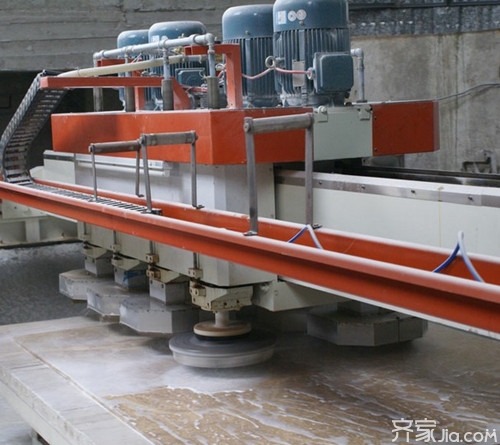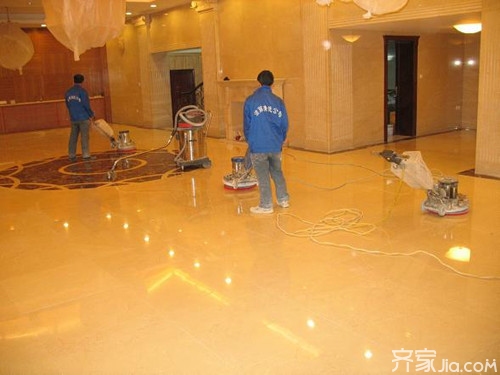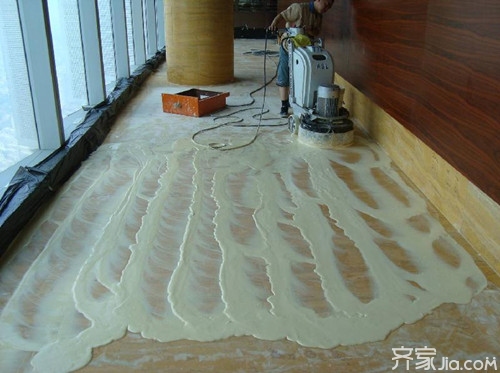Do you know how to polish stone ? The stone is polished, the polished stone is placed on the processed product, and the polishing effect is achieved by using the mechanical equipment for rapid operation and “dry polishing and wet polishingâ€. The product has strong reflected light on the surface, which is commonly referred to as gloss. degree. Stone polishing is a necessary process flow in stone stone surface treatment or stone processing. The main principle is the use of pressed abrasive blocks synthesized from inorganic acids, metal oxides, etc., in combination with the mechanical disc pressure, high-speed grinding force, and frictional heat energy. The grinding block polishing process before the stone care crystal surface treatment is the physical and chemical cooperation process between the stone surface layer and the chemical substance. If you do not consider the internal factors of the stone itself, in terms of polishing process alone, the main factors that affect the stone polishing are the type of polishing agent, polishing liquid (paste), polishing abrasives and polishing process parameters. Here I come to understand how to polish the stone, and the stone polishing step.

How to Polish Stone - Steps
Nowadays many companies are engaged in polishing work, and there are also many machines specializing in polishing. Polishing is a necessary process for marble processing. The price of marble polishing is also one of the focuses of people's attention. For marble processing, there are mainly several steps, such as rough grinding, fine grinding, fine grinding, polishing, etc. After a few steps, the marble will have a better luster.
How to polish stone - the difference between polishing and waxing
First, the essential difference
1. The polishing of marble grinding blocks is a necessary process flow for the prelude of stone crystal surface processing or stone processing. Its main principle is the use of pressed abrasive blocks synthesized from inorganic acids, metal oxides, etc., in combination with the pressure of mechanical grinding discs, high-speed grinding forces, and frictional thermal energy, and the effect of water on the relatively smooth marble surface for physical and chemical cooperation. As a result, a new bright crystal layer is formed. This crystal layer has a super bright, clear luminosity with a luminosity of 90-100 degrees. This crystal layer is a modified crystal layer of the stone surface (1-2 mm thick).
2. Marble cleaning is the prelude to marble waxing and polishing. Marble cleaning, waxing and polishing are the popular marble cleaning and protection measures in the early 1980s and 1990s. Now, they have lost the significance of the market and existence. Its essence is a thin coating of a polymer of acrylic resin and emulsion covered on the surface of a new stone (polished plate), which is commonly known as water wax or floor wax. After a high-speed, low-pressure polishing machine with a fiber mat rubbing on the surface of the stone to make the resin coating a brighter process. Due to the product's renewal, special light waxes, paraffin polishes, etc. appeared later. This coating is similar to oil varnish on wood floors.
3. The grinding block polishing process before the marble treatment crystal surface treatment is the physical and chemical cooperation process between the stone surface layer and the chemical substance. The stone surface and the bottom layer are completely integrated into one whole, and there is no escape layer.
4. The wax layer above the marble waxing is attached to the surface of the stone, a layer of resin film, and there is no compound reaction with the stone itself. The wax layer can be gently scooped with a blade to cut the wax film off the stone surface.
Second, the difference between appearance
1, marble grinding block polishing is a prelude to the stone care crystal surface treatment, stone care after polishing high brightness, high clarity, wear-resistant, resistant to step, not easy to scratch, is the use of stone features the true embodiment and value extension.
2. The luminosity of the stone after waxing and polishing is low, the luminosity is not clear, and it is very vague, it is not wearable, it is not resistant to water, it is easy to scratch, and the oxidation turns yellow to reduce the essential image of the stone.
Third, the difference between extension and operation
1. The continuous care of the crystal layer and crystal layer after the polishing of the stone grinding block (commonly known as the crystal face care) does not completely seal the pores, and the stone can still breathe inside and out, and the stone is not easy to be affected. At the same time have a certain degree of waterproof, anti-fouling effect.
2, marble waxing and polishing, the stone pores are completely closed, stone can not be inside and outside the air, so the stone is easy to produce lesions.
3. The continuous care of the crystal layer and the crystal layer after the polishing of the stone grinding block is easy to operate. No cleaning agent is required to clean the ground, and the grinding block can be directly combined with water polishing and chemical dry grinding. Can always be polished and care, can be partially operated. There is no new contrast in the color of the stone surface.
4. After marble polishing, after a period of time, it is necessary to remove the old wax layer and use wax water. At the same time, large-area operation and construction are required, and no partial construction is allowed. After the partial construction, there is a color difference on the surface.
Fourth, the practical significance
1. After the marble has been polished by the polishing block, the luminosity can reach 90-100 degrees, which restores the luminosity of the stone factory and realizes the reproduction of the stone value. Crystal surface treatment can save time, labor, cost, and wear resistance. After waxing and polishing the marble, the surface brightness of the marble is reduced, the blur is not clear, and the functional value of the stone is reduced, which is not ornamental.
2. The difference between the above nature and appearance can be found: marble waxing and polishing must be eliminated and faded out of the market. Due to the advanced technological principles and methods of marble grinding and polishing crystal face care, it can make marble more ornamental and prolong its service life.

Two determinants of the effect of stone polishing
(1) The type of polishing agent
Although the polishing agent is a special polishing material, the difference between it and the grinding material is mainly reflected in the processing mechanism. In principle, there are some low hardness micropowder materials that can also be used as polishing agents. However, usually the high hardness polishing agent is better than the low hardness, and the application range is also wide. Diamond polishing powder, for most of the stone polishing, can achieve a more satisfactory polishing effect.
(2) Polishing liquid (paste)
Water is a commonly used polishing solution. It can serve both as a grinding cooling and as a medium for physical and chemical reactions during polishing.
If the polishing of stone is based on mechanical machine/grinding, such as diamond powder, the polishing liquid is generally better with oil organic liquid, such as sewing machine oil. Its cooling, lubrication and dispersion are excellent.
Diamond paste, both water and oily, can also be added with colorants. Its formula is:
Abrasive + dispersant + carrier + water + colorant.
(3), polishing plate (with, grinding block)
The flat stone light panel is a form of expression processing for stone surface grinding. Hard disks made of metal materials are often used as polishing disks. The polished surface of the floppy disk is easily yielded to a concave surface when the stone is pressed, and is suitable for arc surface polishing. The hard disk wear resistance, adsorption is good, and has a certain degree of elasticity, the effect of polishing the flat stone is also relatively good.
(4) Polishing process parameters
Process parameters include polishing agent concentration and supply, polishing pressure and line speed. Before less than a certain concentration value, the polishing rate increases with the increase of the polishing agent concentration. After the concentration value reaches the maximum, if the concentration is further increased, the polishing rate is decreased. Similarly, when the supply amount of the polishing agent is a certain value, the polishing rate is the maximum, and if the supply amount is continued to increase after that, the polishing rate is decreased. Appropriately increasing the pressure during polishing can increase the polishing speed, but the pressure is too large and the grinding effect is enhanced, which is not conducive to the formation of a glossy surface. The polishing speed depends on the rotation speed of the polishing plate, but if the line speed is too large, the polishing agent will be thrown away, resulting in waste.

(5) The quality of the previous process and the roughness of the stone surface
If you consider the internal factors that the stone itself has, such as the mineral composition of the stone material, it is mainly represented by the technical characteristics of stone polishing.
1 Stones composed of different minerals have different polishing process characteristics. Such as the main composition of serpentine mineral stone, such as large green marble, it belongs to toughness, can be considered, but not easy to polish the stone.
2 marble contains a certain amount of earth minerals, it will also affect the gloss of the stone. A typical example is Anhui red snail. The rock name is selected stratum limestone. The parallel plane sawing panels are flower-like creatures that resemble snails and are very beautiful. However, because the ore contains a certain amount of clay minerals, it is difficult to achieve a gloss of more than 85 after polishing.
(3) Loose granites tend to have a certain degree of weathering (clayification or hydromica) in the minerals of the cloud length, and the polishing effect is also difficult to reach the level of polishing of fresh granite. This should be the quality of the stone.
In theory, different minerals should use different polishing agents. Polishing is a kind of fine processing technology of stone material, and some people call it surface enhancement technology. There are many factors influencing the stone polishing. There are problems in the process conditions and parameters of the polishing process, as well as the types and auxiliary materials of the polishing agent and the problems of the polishing plate (or block), and also related to the composition and quality of the stone minerals. .
Editor's summary: The above is how the stone polishing professional analysis: a few decisive factors related to the polishing effect of the stone, I hope to help meet the needs of friends! For more information, please continue to follow our website, follow-up will show more exciting content. You can also purchase more of your favorite products on Qijia Mall!
High-grade stone stone cabinet decoration stone antique stone stone background wall offer
Organic salts are salts that are moderately neutralized by organic acids and alkaloids. Only a small number of groups in the organic structure are ions (carboxyl groups, etc.). They act on organic structures, such as drugs, vitamins, etc. Salts are made to make water-insoluble organic matter soluble.
Organic salts are organic acids, or salts formed by the reaction of organic bases with other acids and bases (either organic or inorganic). Such as Sodium Acetate (organic acid, inorganic alkali salt), tetrabutylammonium bromide (inorganic acid, organic base), pyridinium Acetate (organic acid, organic base), sodium methyl (alkyl salt), sodium ethoxide (strong base)
Inorganic Salts,Inorganic Potassium Salts,Inorganic Ferrous Salts,Inorganic Sodium Salts
Jiangsu Kolod Food Ingredients Co., Ltd. , https://www.kolodchem.com